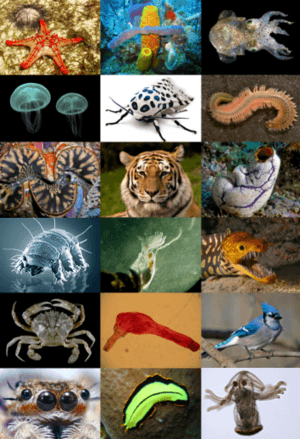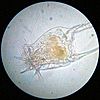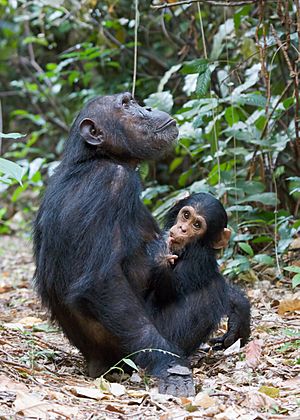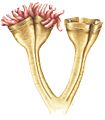Animal facts for kids
Quick facts for kids Animals |
|
|---|---|
 |
|
| Various animals | |
| Scientific classification | |
| Domain: | |
| Kingdom: |
Animalia
|
Animals are eukaryotic organisms with many cells. They do not use light to get energy as plants do. Animals use different ways to get energy from other living things. They may eat other living things, though some are parasites or have photosynthetic protists as symbionts.
Most animals are mobile, meaning they can move around. Animals take in oxygen, and give out carbon dioxide. This cellular respiration is part of their metabolism (chemical working). In both these ways they are different from plants. Also, the cells of animals have different cell membranes to other eukaryotes like plants and fungi. The study of animals is called zoology.
Plants are also multicellular eukaryotic organisms, but live by using light, water and basic elements to make their tissues.
Grouping animals
There are many different types of animals. The common animals most people know are only about 3% of the animal kingdom. When biologists look at animals, they find things that certain animals have in common. They use this to group the animals in a biological classification. They think several million species exist but they have only identified about one million.
Animals can mainly be divided into two main groups: the invertebrates and the vertebrates. Vertebrates have a backbone, or spine; invertebrates do not.
Vertebrates are:
- fish (or 'fishes': both ways are correct)
- amphibians
- reptiles
- birds
- mammals
Some invertebrates are:
In scientific usage, humans are considered animals, in everyday nonscientific usage, humans are often not considered to be animals.
Numbers and habitats
The following table lists estimated numbers of described extant species for the animal groups with the largest numbers of species, along with their principal habitats (terrestrial, fresh water, and marine), and free-living or parasitic ways of life. Species estimates shown here are based on numbers described scientifically; much larger estimates have been calculated based on various means of prediction, and these can vary wildly. For instance, around 25,000–27,000 species of nematodes have been described, while published estimates of the total number of nematode species include 10,000–20,000; 500,000; 10 million; and 100 million. Using patterns within the taxonomic hierarchy, the total number of animal species—including those not yet described—was calculated to be about 7.77 million in 2011.
| Phylum | Example | No. of Species |
Land | Sea | Fresh water |
Free- living |
Parasitic |
|---|---|---|---|---|---|---|---|
| Annelids |  |
17,000 | Yes (soil) | Yes | 1,750 | Yes | 400 |
| Arthropods |  |
1,257,000 | 1,000,000 (insects) |
>40,000 (Malac- ostraca) |
94,000 | Yes | >45,000 |
| Bryozoa |  |
6,000 | Yes | 60-80 | Yes | ||
| Chordates |  |
65,000 45,000 |
23,000 |
13,000 |
18,000 9,000 |
Yes | 40 (catfish) |
| Cnidaria |  |
16,000 | Yes | Yes (few) | Yes | >1,350 (Myxozoa) |
|
| Echinoderms |  |
7,500 | 7,500 | Yes | |||
| Molluscs |  |
85,000 107,000 |
35,000 |
60,000 |
5,000 12,000 |
Yes | >5,600 |
| Nematodes |  |
25,000 | Yes (soil) | 4,000 | 2,000 | 11,000 | 14,000 |
| Platyhelminthes |  |
29,500 | Yes | Yes | 1,300 | Yes | >40,000 |
| Rotifers |  |
2,000 | >400 | 2,000 | Yes | ||
| Sponges |  |
10,800 | Yes | 200-300 | Yes | Yes | |
|
|
|||||||
Life styles
The animal mode of nutrition is called heterotrophic because they get their food from other living organisms. Some animals eat only plants; they are called herbivores. Other animals eat only meat and are called carnivores. Animals that eat both plants and meat are called omnivores.
The environments animals live in vary greatly. By the process of evolution, animals adapt to the habitats they live in. A fish is adapted to its life in water and a spider is adapted to a life catching and eating insects. A mammal living on the savannahs of East Africa lives quite a different life from a dolphin or porpoise catching fish in the sea.
The fossil record of animals goes back about 600 million years to the Ediacaran period, or somewhat earlier. During the whole of this long time, animals have been constantly evolving, so that the animals alive on Earth today are very different from those on the edges of the sea-floor in the Ediacaran. The study of ancient life is called palaeontology.
Related pages
Images for kids
-
Animals are unique in having the ball of cells of the early embryo (1) develop into a hollow ball or blastula (2).
-
Predators, such as this ultramarine flycatcher (Ficedula superciliaris), feed on other animals.
-
Hydrothermal vent mussels and shrimps
-
The blue whale is the largest animal that has ever lived.
-
Ecdysis: a dragonfly has emerged from its dry exuviae and is expanding its wings. Like other arthropods, its body is divided into segments.
-
Jean-Baptiste de Lamarck led the creation of a modern classification of invertebrates, breaking up Linnaeus's "Vermes" into 9 phyla by 1809.
-
Sides of beef in a slaughterhouse
-
A gun dog retrieving a duck during a hunt
-
Artistic vision: Still Life with Lobster and Oysters by Alexander Coosemans, c. 1660
-
Dickinsonia costata from the Ediacaran biota (c. 635–542 mya) is one of the earliest animal species known.
-
Anomalocaris canadensis is one of the many animal species that emerged in the Cambrian explosion, starting some 539 million years ago, and found in the fossil beds of the Burgess shale.
See also
 In Spanish: Animalia para niños
In Spanish: Animalia para niños
















